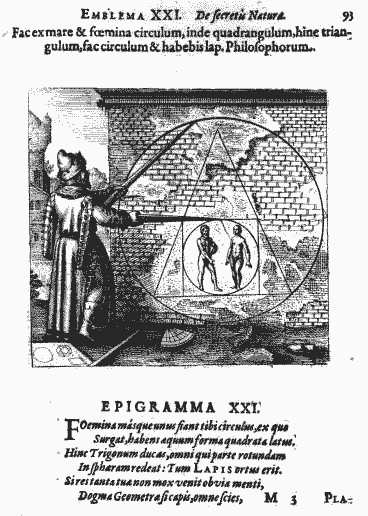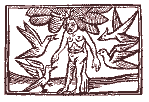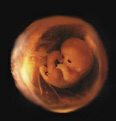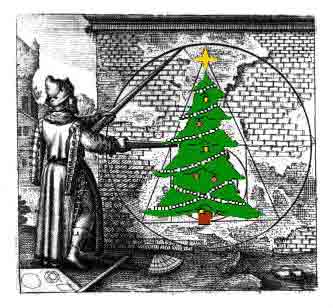|
SAI
SPIEGARE IN
TERMINI SEMPLICI LA
SEZIONE AUREA?
...
il mio violoncello
dalle "proporzioni
auree"..........)",
davvero??
sai
tra quali elementi?

Fai
dell'uomo e donna un Cerchio, da quello fai un Quadrangolo,
di quello un Triangolo, dello stesso un Cerchio, e avrai la
Pietra Filosofale.
|
The
Discourse:

Plato that most Excellent Philosopher was of the Opinion that
those notions or Ideas which are the Foundations of Arts and Sciences
are as it were actually engraved and imprinted upon the mind of
Man, and that by the Repetition and remembrance of them he can
apprehend and know all manner of learning. To prove this he introduced
a young Lad, rude and uninstructed, and asked him such Geometricall
Questions that the Youth might be perceived to answer right whether
he will or no, and although before he understood nothing of the
matter, yet by these answers seemed to have penetrated into the
Depths of so abstruse a Science. From whence he concluded that
in children all Discipline and Doctrine is not at first taken
in and learnt, but called to mind and brought by the memory, alluding
by this to his Annus Magnus or Great Year, of which he says that
forty eight thousand solar Years agoe, before the Revolution of
the Heaven, the same persons, thinges and actions were then in
being which are at the present time, whensoever that is. But every
person may perceive that these thinges have no more foundations
of truth in them than mere dreams. We do not deny that there are
some sparks of notions and mere powers imprinted in us, which
must be reduced into act by institution, but we utterly deny that
they are such or so great as to be the Summaries of Arts and Sciences
without any precedent instruction.
It will then be asked from whence Arts and Sciences have proceeded
if men have not invented them, or whether they were not at first
delivered from Heaven by the God of the Nations. I answer by saying
that burning Coals may lye hid under Ashes in so great a quantity
that if the Ashes were but removed they would be sufficient for
the dressing of meat or warming oneself; but this is a different
thinge from affirming that only some small spark lyes there, which
before it can be of use and administer a sufficient heat must
be cherished and nourished with fresh fewell by human Act, Care
and Industry, or otherwise it would be easily extinguished. The
Aristotelicks assert the latter as the Platonicks do the former.
Reason and Experience seem to agree with this latter, whereas
the first depends only upon Imagination and Phansy. Here it may
be asked why Plato wrote over the Door of his school that no one
ignorant of Geometry was there to be admitted, seeing he affirmed
that little boys did actually know it. Are men more unlearned
than boys? Or when they grow up, do they forget what they knew
when children? That cannot be supposed, for we see that Brutes
do by the instinct of Nature as soon as they are brought forth
abhor and avoid the danger of Fire, Water, Precipices and the
like. Yet an infant neither knows nor shuns such thinges. Why
do not the Bee, Fly and Gnatt precipitate themselves into the
Fire, seeing that they cannot know by experience that danger will
arise from it? Because nature has taught them, but she has not
done so by man when he is newly born. If Geometry is so easy and
naturall to children, how comes it to passe that Plato did not
know the Quadrature of a Circle, so that Aristotle who was his
schollar affirms that it might be known but was not yet known?
But that this was not unknown to the Philosophers of Nature is
apparent from this: That they command a Circle to be turned into
a Quadrangle, and this by a Triangle to be reduced again to a
Circle. By a circle they understand the most simple body without
angles, as by the Quadrangle they do the four Elements. It is
as if they should say: The most simple corporeal Figure that can
be found is to be taken and divided into four Elementall Colours,
becoming an Equilaterall Quadrangle. Now every man understands
that this Quadration is Physicall and agreeable to Nature, by
which far more benefit accrues to the Publick, and more light
appears to the mind of Man, than by any meere Theory of Mathematicks
when abstracted from Matter. To learn this perfectly a Geometrician
acting upon solid bodyes must enquire what is the depth of solid
Figures, as for example the Profundity of Sphere and Cube must
be knowne and transferred to manuall use and practice. If the
Capacity or Circumference of the sphere be 32 foot, how much will
one of the sides of the Cube be to Equalize the Capacity of this
Sphere? On the contrary, one might look back from the Measures
which the Cube contains to the feet of each Circumference.
In like manner the Philosophers would have the Quadrangle reduced
into a Triangle, that is, into a Body, Spirit and Soul, which
three appear in the three previous colours before Rednesse: that
is, the Body or earth in the Blacknesse of Saturn, the Spirit
in the Lunar whitenesse as water, and the Soul or air in the Solar
Citrinity. Then the Triangle will be perfect, but this again must
be changed into a Circle; that is, into an invariable rednesse,
by which operation the woman is converted into the man and made
one with him, and six the first of the perfect numbers is absolved
by one, two having returned again to an unity in which there is
Rest and eternall peace.
|
!
!
!
!
!
*
* * *
* * * * *
«Come
in ineffabile armonia
Quel divino Ternario in un s'unisca,
E come nostr'anima fruisca
Quel bene eterno in somma Melodia»
(P.
Colonna in Kircher, Musurgia Universalis, Roma 1650.
Canzone dedic., paragrafo "Cantano i cieli")

»Alles
erklärt sich wohl«, so sagt mir ein Schüler, »aus
jenen
Theorien, die uns weislich der Meister gelehrt.«
Habt ihr einmal das Kreuz von Holze gezimmert,
Paßt ein lebendiger Leib freilich zur Strafe daran.
(«Tutto si spiega benissimo»,
così mi dice uno studente,
«dalle teorie che ci insegnò un saggio maestro.»
Quando abbiate ben tratto dal legno una croce,
di sicuro troverete anche un corpo vivente che vi si adatti per
il castigo.)
Johann Wolfgang
von Goethe, "Epigramme. Venedig 1790", epigramma 79)
~
Bene, ci sono
decine di libri di liuteria che spiegano a fondo l'ideazione delle forme
del violino, secondo la sezione aurea. Tutti i liutai non solo eseguono
con esattezza, ma sanno pure spiegare perché lo fanno... ma al
violinista, ahimè, non interessano tali nozioni... Ci sono centinaia
di libri per imparare le regole dell'Armonia musicale, così come
fu stabilita nel Cinquecento. Tutti gli studenti di Conservatorio la
eseguono con esattezza, e sanno pure spiegare ciò che han fatto...
ma né allo studente, né al professore, ahimè, interessano
più tali nozioni...
Poco più
in alto, in questo "foglio", vedi Ermete Trismegisto che illustra
come trovare la Pietra Filosofale (Michael Maier, Atalanta fugiens,
1617), e dopo tanti anni, ancora il mondo crede che quella pietra abbia
un peso misurabile su questa terra...
Schüler
macht sich der Schwärmer genug und rüret die Menge,
Wenn der vernüftige Mann einzelne Liebende zählt.
Wundertätige Bilder sind meist nur schlechte Gemälde:
Werke des Geists und der Kunst sind für den Pöbel nich da.
(L'esaltato raccoglie discepoli a bizzeffe, e
muove le masse,
mentre l'uomo assennato può contare solo pochi amici, che l'amano.
Le immagini miracolose sono quasi sempre dei dipinti scadenti:
le opere d'arte e d'ingegno non sono per la massa.)
Johann
Wolfgang von Goethe, "Epigramme. Venedig 1790", epigramma
15)

|



